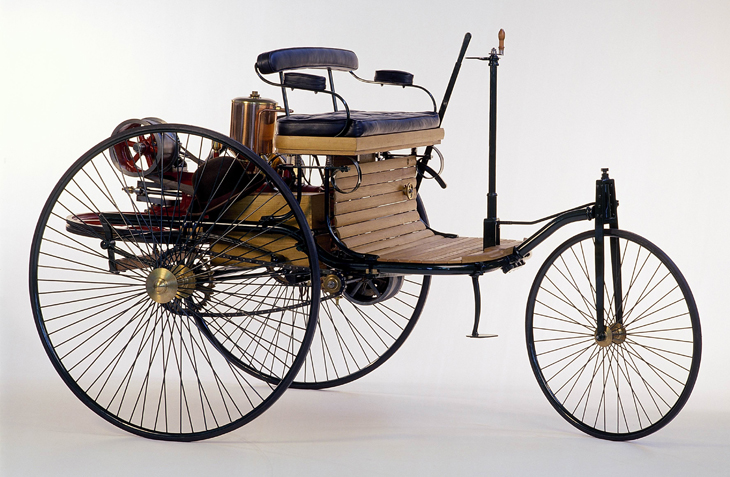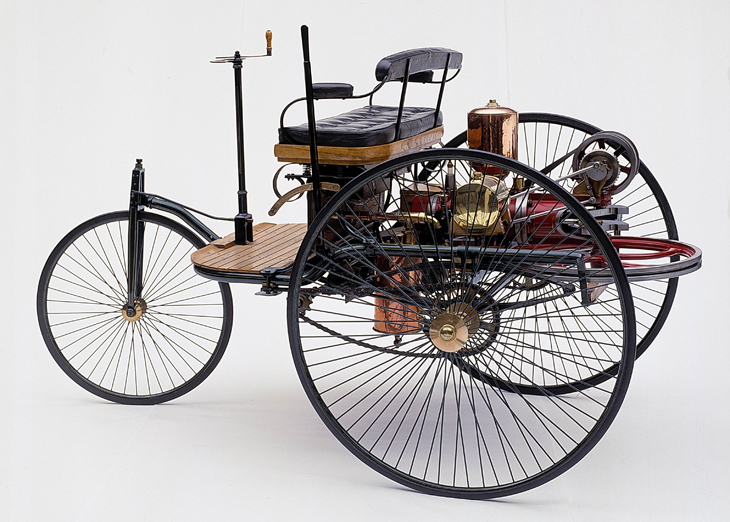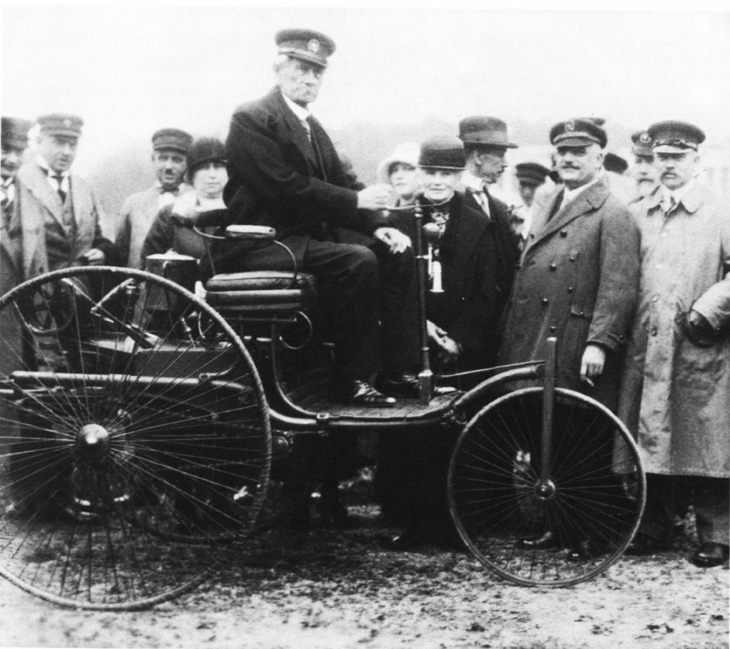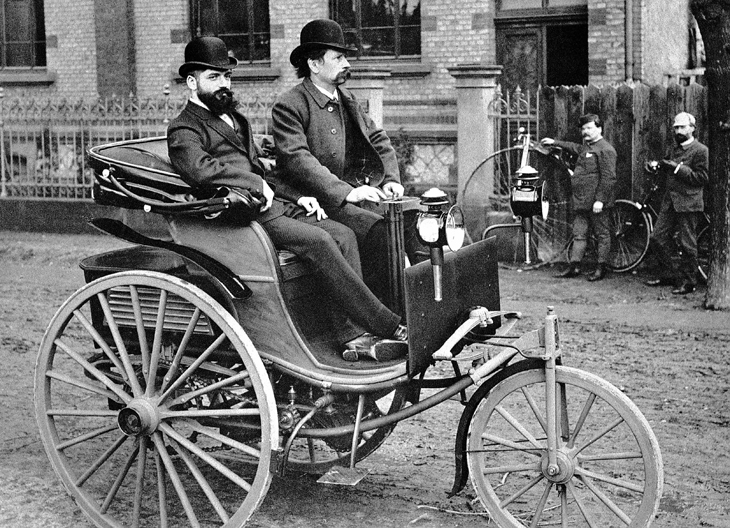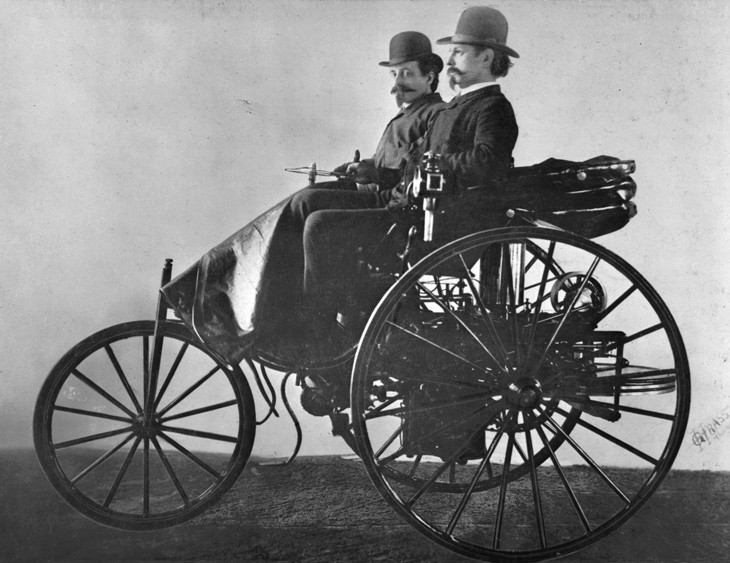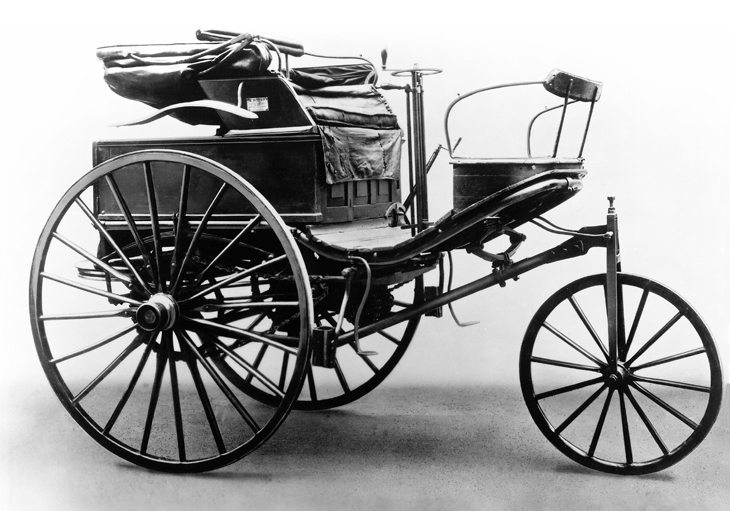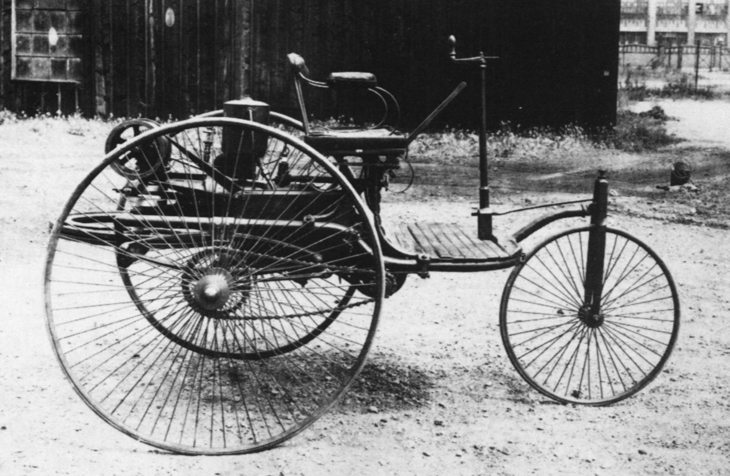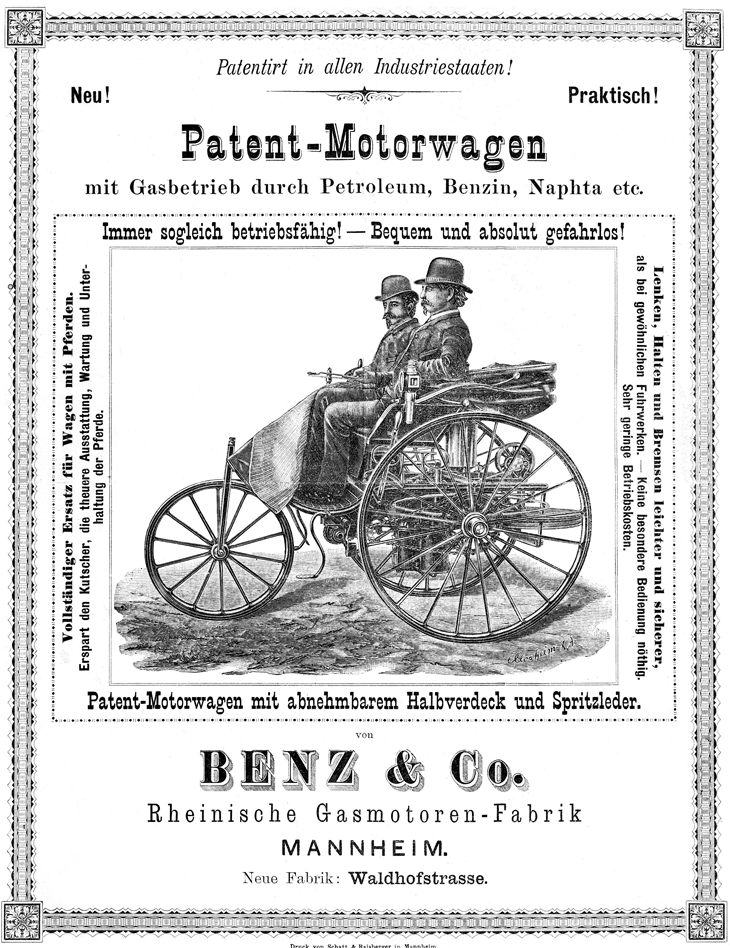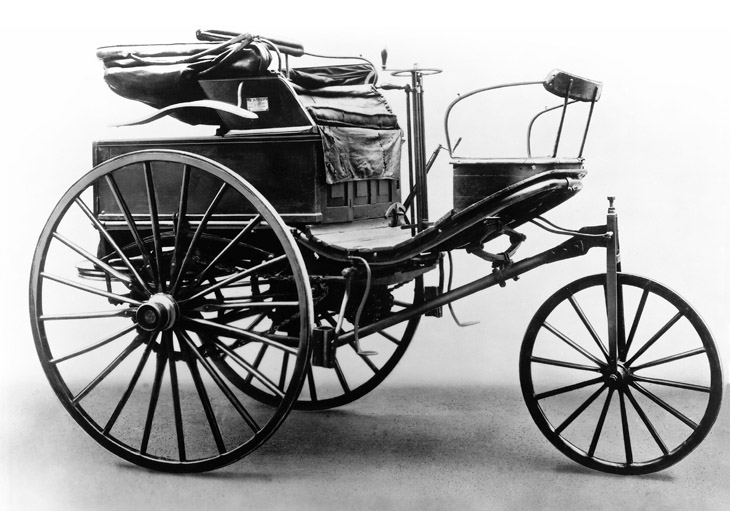|
|
|
|
|
|
|
By the standards of the day, this engine was positively lightweight, tipping the scales at around 100 kilograms. Other characteristic features were its open crankcase, the intake slide valve controlled by an eccentric rod, the exhaust poppet valve operated via a cam disc, rocker arm and pushrod, and the drip-feed lubrication system. Benz's design had the large flywheel mounted horizontally on the chassis, because he feared the gyroscopic effect of a vertical arrangement would interfere with the steering and stability of the vehicle. Preparation of the fuel-air mixture was handled by the 'surface' or evaporative carburettor, another Benz design, which also doubled as a 4.5 litre fuel reservoir. The vehicle required around 10 litres of petrol for every 100 kilometres travelled. The fact that fuel capacity was inadequate for longer distances was not initially a major concern. First and foremost, the purpose of the Benz Patent Motor Car was to demonstrate that the overall design – and hence the concept of the automobile – was fit for purpose. The precise composition of the petrol-air mixture was controlled by a sleeve valve, the position of which determined power output by opening or closing holes for the auxiliary intake duct. This sleeve valve was easily accessible beneath the driver's seat. The engine was started with a hearty swing of the flywheel. Benz spent a great deal of time experimenting with the ignition, before he eventually came up with a solution that suited the low battery voltage of the day. He transformed it up to a higher voltage using a Ruhmkorff 'spark' coil. The spark plug was also one of his own designs. Cooling the internal combustion engine presented a particular problem, since unlike a stationary engine it could not merely be attached to a cold water supply housed inside a building. Benz opted for simple evaporation cooling, which proved highly effective and more than adequate for the low engine output. The steam produced was simply allowed to escape, meaning that water consumption during a journey was considerable. More efficient closed-loop cooling systems were not developed until around ten years later, when increased engine outputs and the higher demands placed on a vehicle's reliability made this a necessary improvement. Chassis and body The vehicle frame of the Patent Motor Car was shaped and welded together from tubular steel. Since this was a rear-wheel drive vehicle – pushed from behind, in other words – the steering was necessarily of a different design to that required by a traction vehicle. The conventional drawbar steering system used with carriages was not an option. So for the sake of simplicity, Benz initially opted for a single steered front wheel, thus creating a three-wheeled vehicle. The front wheel was mounted in an unsprung fork and was turned using a lever attached to a toothed rack. Not until several years later, in 1893, did Benz invent axle-pivot steering for two steered front wheels, one of the most significant milestones in automotive design. Benz produced the three wire spoke wheels with solid rubber tyres himself, buying in only the rims. As was typical of bicycle designs of the day, the front wheel was mounted on a ball bearing, the rear wheels in white alloy bushings. The car was driven at the rear wheels by two chains to the right and left of the throughdrive countershaft; the rear wheels were attached to the frame via a rigid axle and fully elliptic springs. It was not by chance that the Patent Motor Car bore certain similarities to the bicycle: not only was the bicycle considered state-of-the-art, it also gave Benz inspiration for a vehicle that was both stable and lightweight. The world's first car had just one speed on the countershaft in the form of a fixed drive disc with integrated differential and adjacent idler disc; no transmission therefore with two or more speeds and no reverse gear. Thanks to the idler disc, the flat belt linking the engine and the countershaft simultaneously served as a clutch. To slip the vehicle into gear in preparation for moving off, the belt was simply shifted from the idler disc to the fixed drive disc. Driving speed was regulated by means of the sleeve valve located beneath the driver's seat. The reservoir for cooling water was located above the engine. The vehicle was braked using a hand lever that acted on the countershaft belt disc. The foot brake had not yet been invented. The leather-upholstered seat bench was attached directly to the frame and mounted on elegantly contoured springs. A low, leather-bound rail at the back and sides provided additional support.
Carl Benz at the wheel of his Patent Motor Car in 1925, during the transport exhibition on Theresienwiese, Munich's trade-fair and public-festival grounds.
The Patent Motor Car of 1887, an advanced version of the first motor car of 1886. At the wheel: Carl Benz, with his commercial clerk Josef Brecht beside him.
The inventor and his creation: Carl Benz (in front) at the wheel of his patent motor car model III, together with Friedrich von Fischer, equally a member of the Board of Management of Benz & Cie. Test drives For reasons of secrecy, preliminary short test drives were held at the factory premises in 1885. The first outing on the open road – staged at night – lasted only a few minutes, since the car came to a standstill after a hundred metres. But before long, one hundred metres turned into one thousand, and with each test the distance got bigger. In his memoirs Benz recalled: "I probably reached a speed of 16 kilometres per hour with the car. My confidence grew with each outing, but on each occasion I also grew to recognise new characteristics of the engine; on the other hand, every journey showed me new improvement possibilities, so that by January 1886 I was ready to apply for a patent for the car." For the first public outing on 3 July 1886, an event documented in a press article, his son Eugen ran alongside the vehicle holding a bottle of fuel, "in order to fill up the tank should the gasoline run out." The Neue Badische Landeszeitung published the following account of the outing on 3 July 1886: "A velocipede powered by ligroin gas (benzene), constructed at the Rheinische Gasmotorenfabrik Benz & Cie. and about which we have already reported in these pages, was trialled earlier today on the Ringstraße and is said to have passed the test satisfactorily." The same author had written on 4 June 1886: "Enthusiasts of the velocipede may be interested to learn that great progress has been made in this field following a new invention by the local firm Benz & Cie. Currently the aforementioned company [...] is building a three-wheeled velocipede powered by an engine similar in design to a gas engine. This engine has a cylinder diameter of 9 cm and is mounted on springs above the axle and between the two rear drive wheels; despite its diminutive size, it is capable of almost one horsepower and achieves 300 revolutions per minute, whereupon the speed of the vehicle can be increased to that of a conventional passenger carriage. [...] The entire vehicle is barely larger than a conventional tricycle and makes a highly pleasing and elegant impression. There can be no doubt that this motorised velocipede will soon make many friends, since it will probably prove itself to be extremely practical for use by doctors, travellers and sportsmen." German Patent No. 37435 for the "vehicle with gas engine operation" Carl Benz applied for a patent for his Motor Car on 29 January 1886. The German Patent No. 37435 is considered the birth certificate of the automobile. It bears the heading: "Vehicle with gas engine operation", and the text begins with the words: "The present design serves for the operation of mainly light vehicles and small boats, such as those used for the conveyance of one to four people. [...] For whichever system, power is provided by a small gasoline engine. This is fed with fuel from an apparatus carried on board, in which gasoline derived from ligroin or other volatile substances is produced. The engine's cylinder is maintained at a constant temperature by the evaporation of water." A French patent was applied for on 25 March the same year. The Benz Patent Motor Car No. I model demonstrated that Carl Benz's idea was viable. Benz used this experience to build a number of other models in quick succession; although these did not differ fundamentally from the original, they featured a number of minor improvements. The No. II model, the engine of which developed 1.1 kW, was also designed originally as a three-wheeler and subsequently converted experimentally to a four-wheeled vehicle. This car, which also featured a prototype axle pivot steering system, represented a further step towards the modern car. It is thought only one example was ever built. The No. III model was improved sufficiently to be sold in small numbers – around 25 units in total. Depending on the variant, each was equipped with an engine with an output of up to 2.21 kW. In addition, the No. III model featured wooden spoke wheels, a small petrol reservoir and a leather-clad, hand-operated block brake that acted directly on the rear wheels. There were also two forward gears, achieved by means of an idler disc and a two-stage fixed drive disc. A No. III model dating from 1888 has survived in its original condition. This now belongs to the collection at the Science Museum, London. Technical data for the Benz Patent Motor Car No. I model, 1886
Contemporary photo of the Benz patent motor car, model no. 3: Such a car from the year 1888 was sold by Emile Roger to Great Britain, as evidenced by the badge. Today, this is the oldest patent motor car in original condition that is known to exist.
|
|
Home < Mercedes-Benz < Mercedes-Benz Cars < Historical Models < 1919-1886
|
